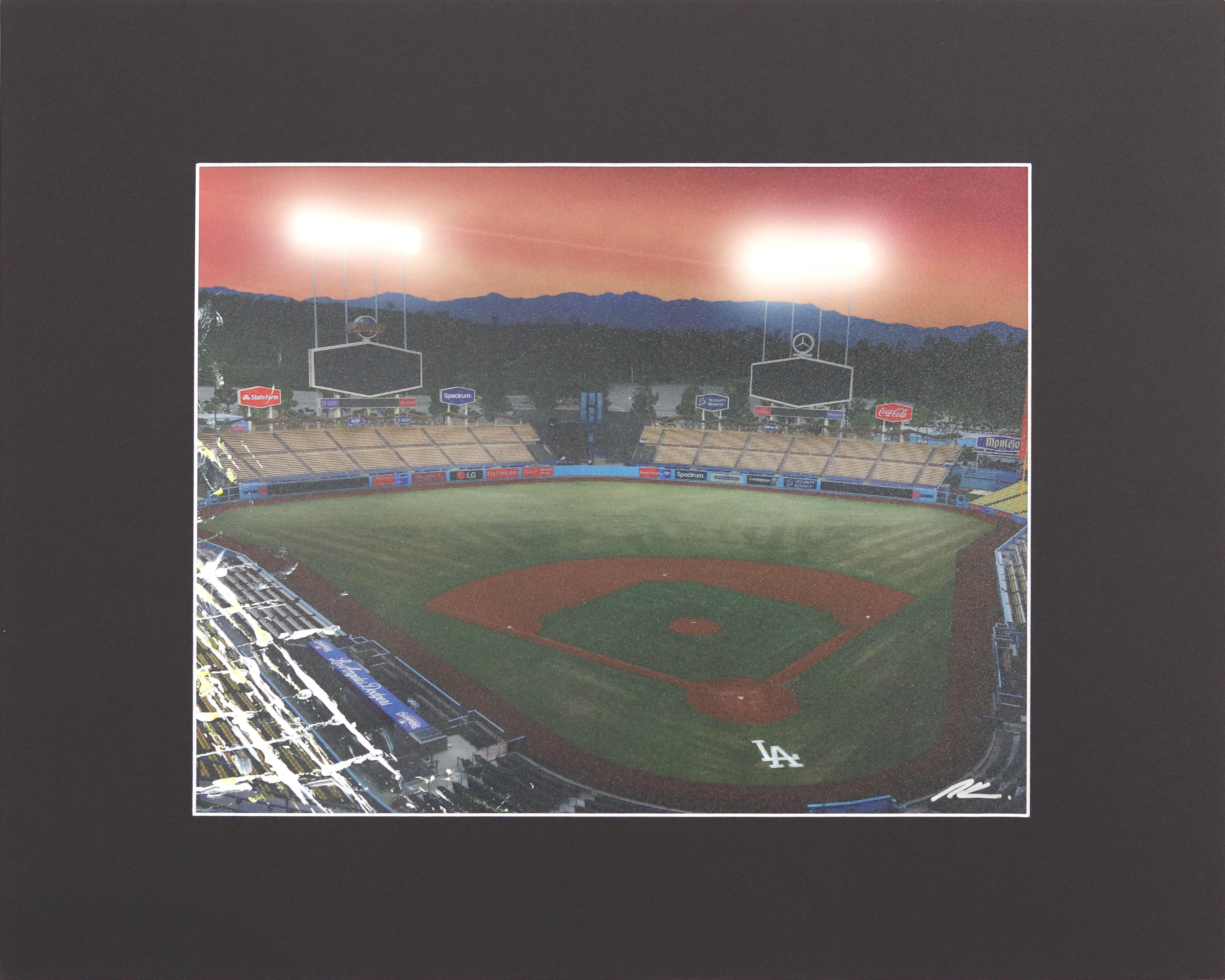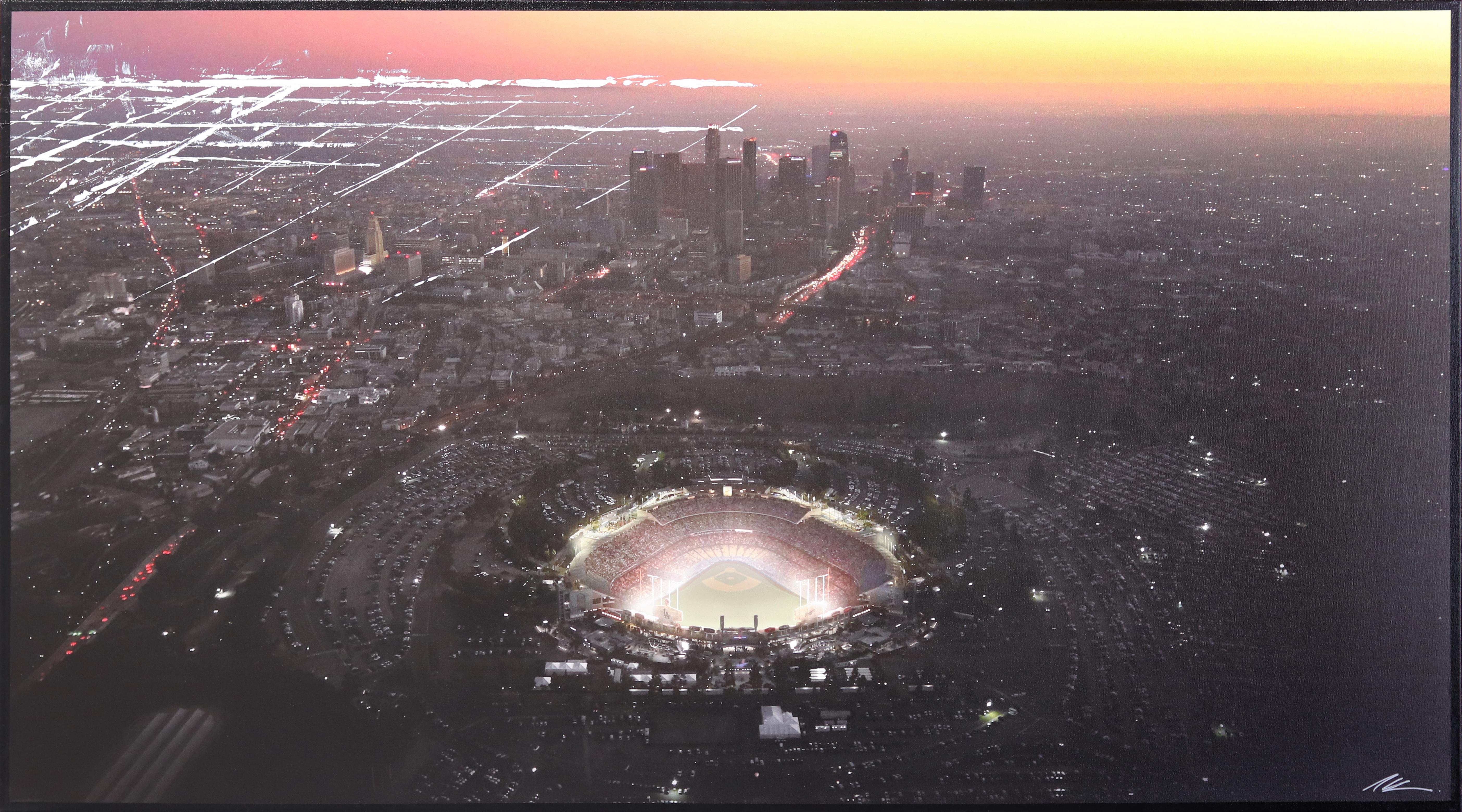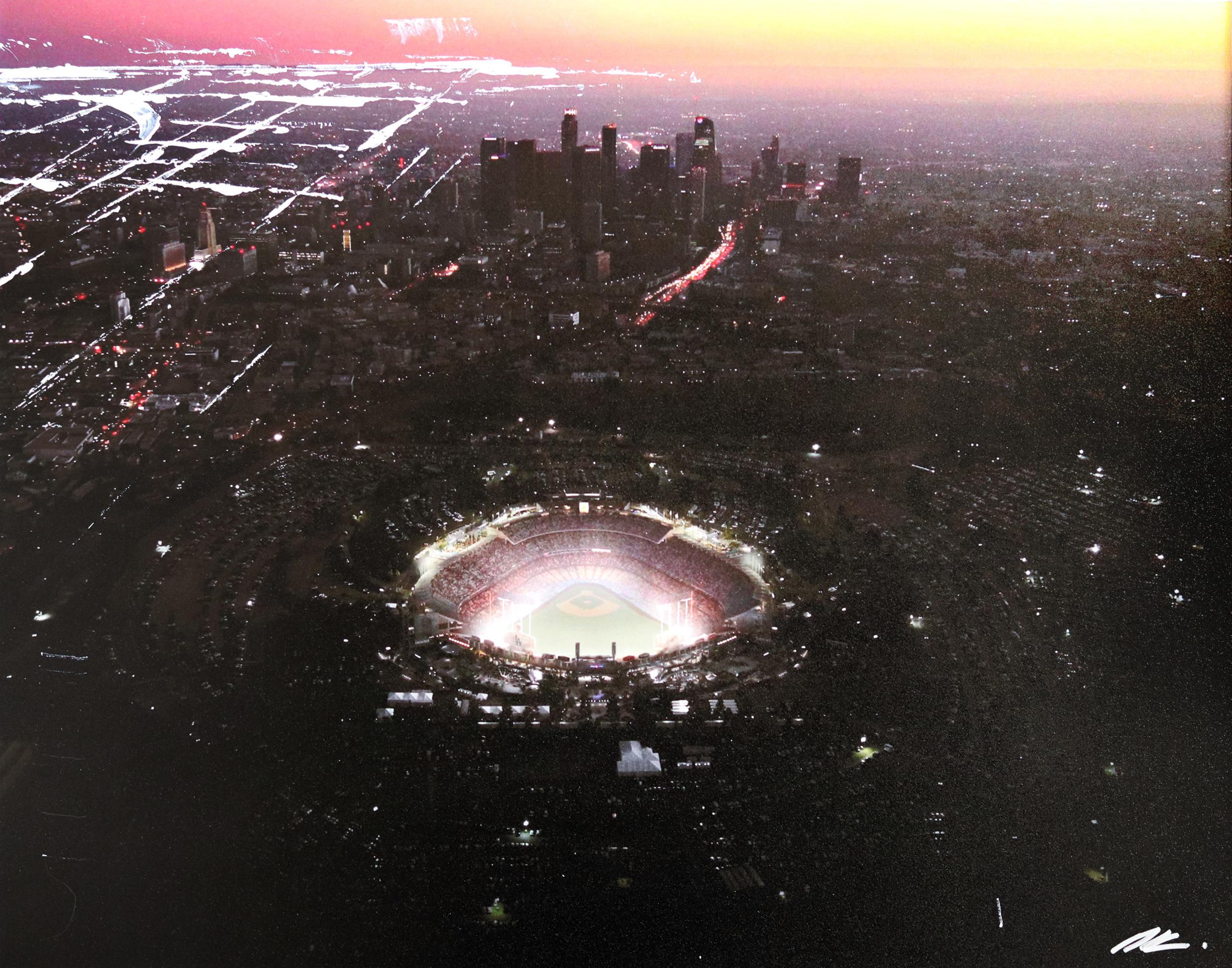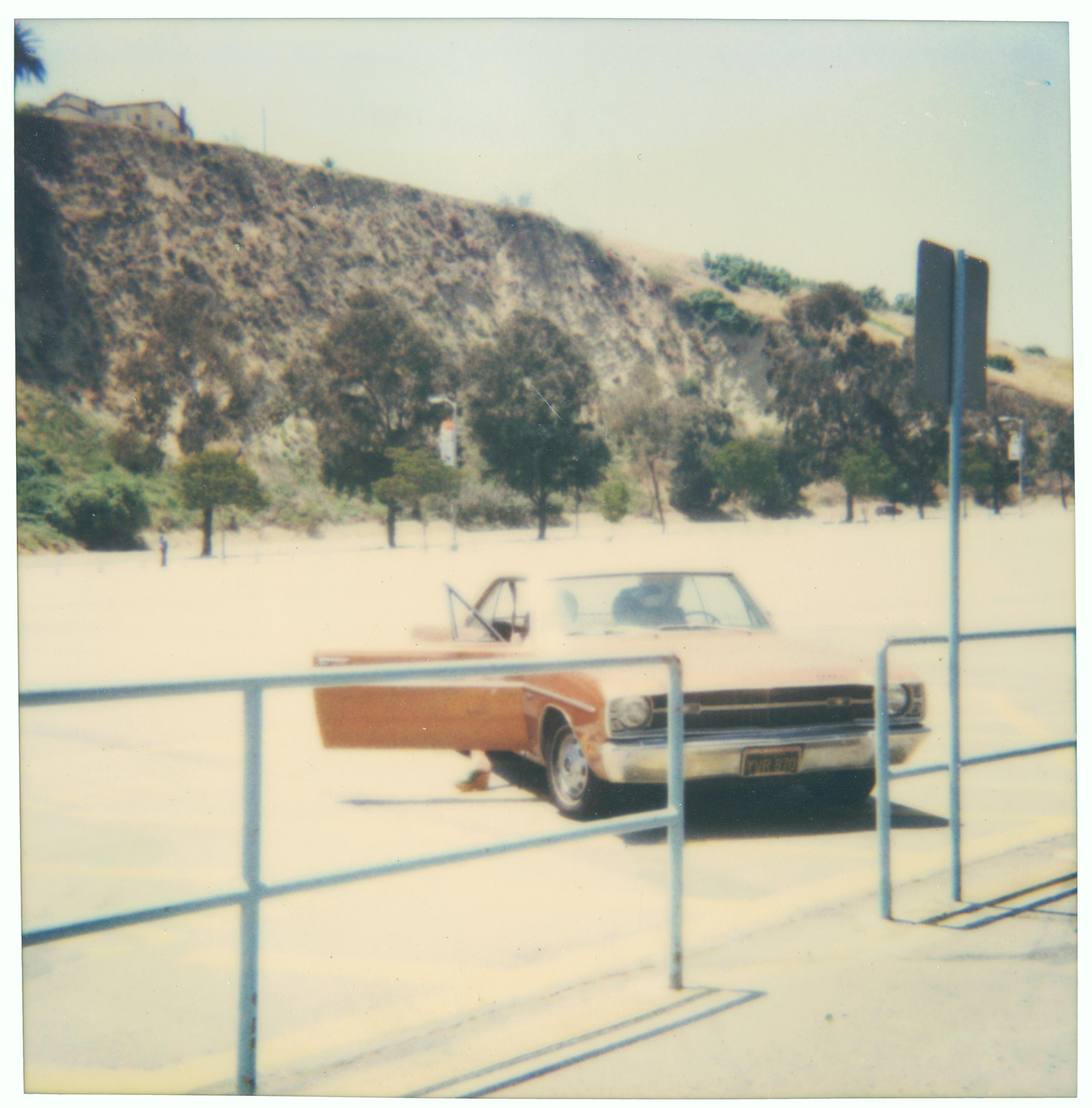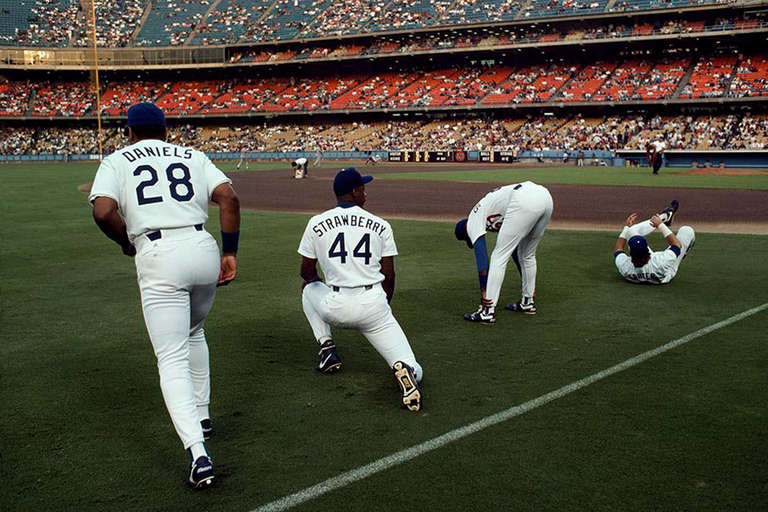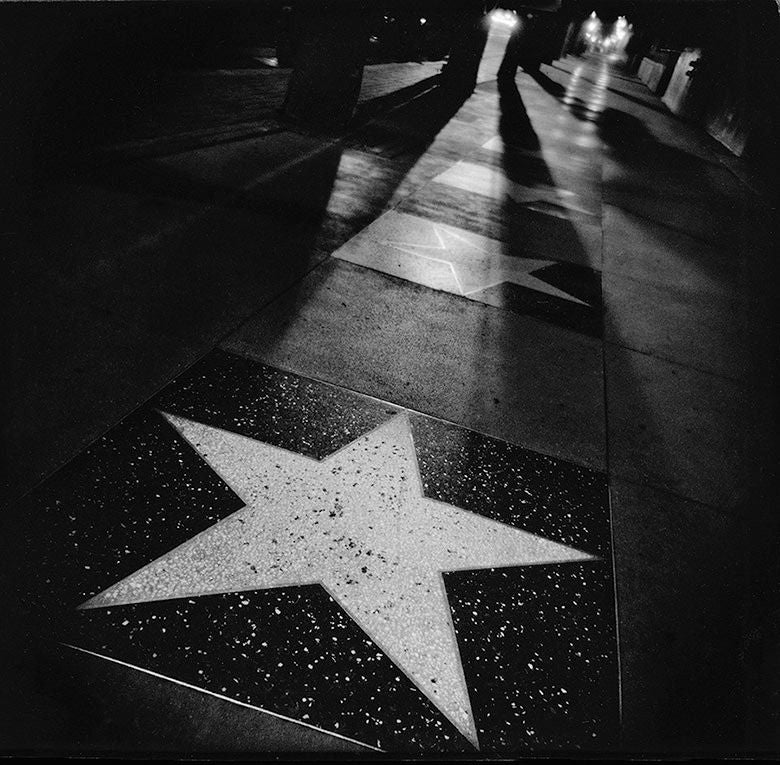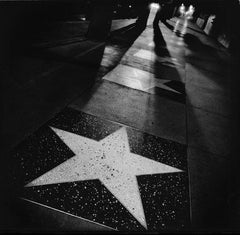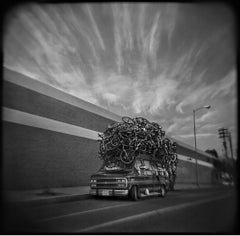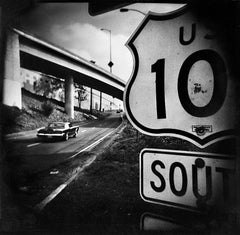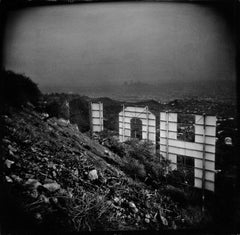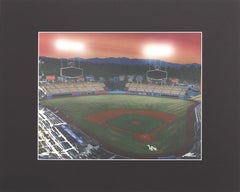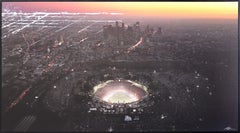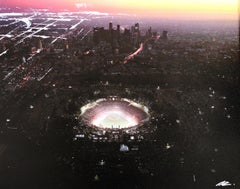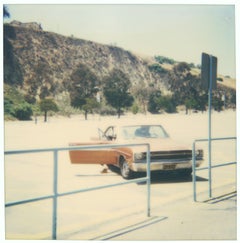Items Similar to Dodger Stadium, Los Angeles
Want more images or videos?
Request additional images or videos from the seller
1 of 4
Thomas Michael AllemanDodger Stadium, Los Angeles2006
2006
$3,000
£2,278.99
€2,625.03
CA$4,291.80
A$4,706.97
CHF 2,427.58
MX$56,228.72
NOK 30,789.11
SEK 28,883.68
DKK 19,610.93
About the Item
Black and White, Sports, Panorama, Landmark, Los Angeles, City Lights, Nighttime, Stadium, City, baseball, stadium, stadium photography, aerial, night, black & white, b&w, photography, vignette, noir, high contrast, people, sports
Listing is for UNFRAMED print. Inquire within for framing.
Edition of 15.
If the exhibition piece is sold or the customer orders a different print size, the photograph is produced upon purchase. Please allow two weeks for production.
Shipping time depends on method of shipping.
Price is subject to availability. The Robin Rice Gallery reserves the right to adjust this price depending on the current edition of the photograph.
ABOUT:
Since the inception of Sunshine & Noir in 2001, Alleman has shot extensively in Los Angeles, New York, San Francisco and other American cities. In his latest iteration Alleman takes a detour beyond the frenetic landscapes of urban America into Paris - playfully guiding the viewer through a simultaneously familiar and foreign geography.
In the exhibition, square and panoramic landscapes and iconic landmarks stretch across the gallery, where Alleman creates intrigue by re-expressing instantly recognizable subjects. Images with blurred, vignetted edges epitomize his surrealist style, haunting throughout the series. His artful mastery at capturing movement is seen in the invitational image, San Fernando Valley, LA, where a van is swallowed by a mass of twisted bicycles. The blurred clouds above give the illusion that the broken down vehicle is actually racing down the highway. This interesting paradox of a decrepit van seemingly in lively motion reflects Alleman’s trademark style - quirky, humorous, and often nostalgic.
His love for the ironic and misplaced becomes further evident in the panoramic California Theater Marquee, LA. Once grandiose, the hotel marquee takes on an eerie, carnival-like quality when shot dilapidated and discarded in a storage yard near the Hollywood Hills. To make his panoramas, Alleman exploits, “the very primitive technology” of his camera. The Holga, a medium-format plastic camera dating from 1982 allows him to “make terrible mistakes” on purpose. He intentionally “under cranks” the film-advance, such that several consecutive pictures bump into and overlap one another, causing the images to bleed and fade together to form an apparent panorama.
Despite “laughable failures” as “focus, exposure and parallax are uncontrollable,” Alleman’s deliberate camera choice achieves a dancing dynamic between lightness and darkness characterizing Sunshine and Noir. “The shutter sometimes bounces, causing partial double-exposures; light-leaks are inevitable, but random. Much to my surprise, however, the freaky results of that technical dysfunction resembled precisely the pictures I’d been dreaming of…” Alleman says.
An acclaimed lifelong photographer, Alleman’s career and technique travelled full circle, but by no simple trajectory. As a photojournalist when clarity and detail were paramount, he mastered Nikons and the highly technical Hasselblad. Opting for messier execution and rudimentary unruliness, Alleman discovers a somewhat hard-edged sentimentality in the show.
A Michigan State University English Literature graduate with no formal photography training, Alleman credits the influence of Henri Cartier-Bresson, Lee Friedlander and Garry Winogrand. As a magazine freelancer, Alleman’s photos have been published regularly in Time, People, Business Week, Smithsonian, and the National Geographic Traveler. Most notably, Alleman was named California Newspaper’s Photographer of the Year in 1995 and Los Angeles Newspaper’s Photographer of the Year in 1996. Nonetheless, the award he is most proud of came in 2011 from Photography Book Now, who awarded Sunshine & Noir, 1st place in the travel book category.
- Creator:
- Creation Year:2006
- Dimensions:Height: 20.5 in (52.07 cm)Width: 50.5 in (128.27 cm)
- Medium:
- Period:
- Condition:
- Gallery Location:Hudson, NY
- Reference Number:1stDibs: G13020611666
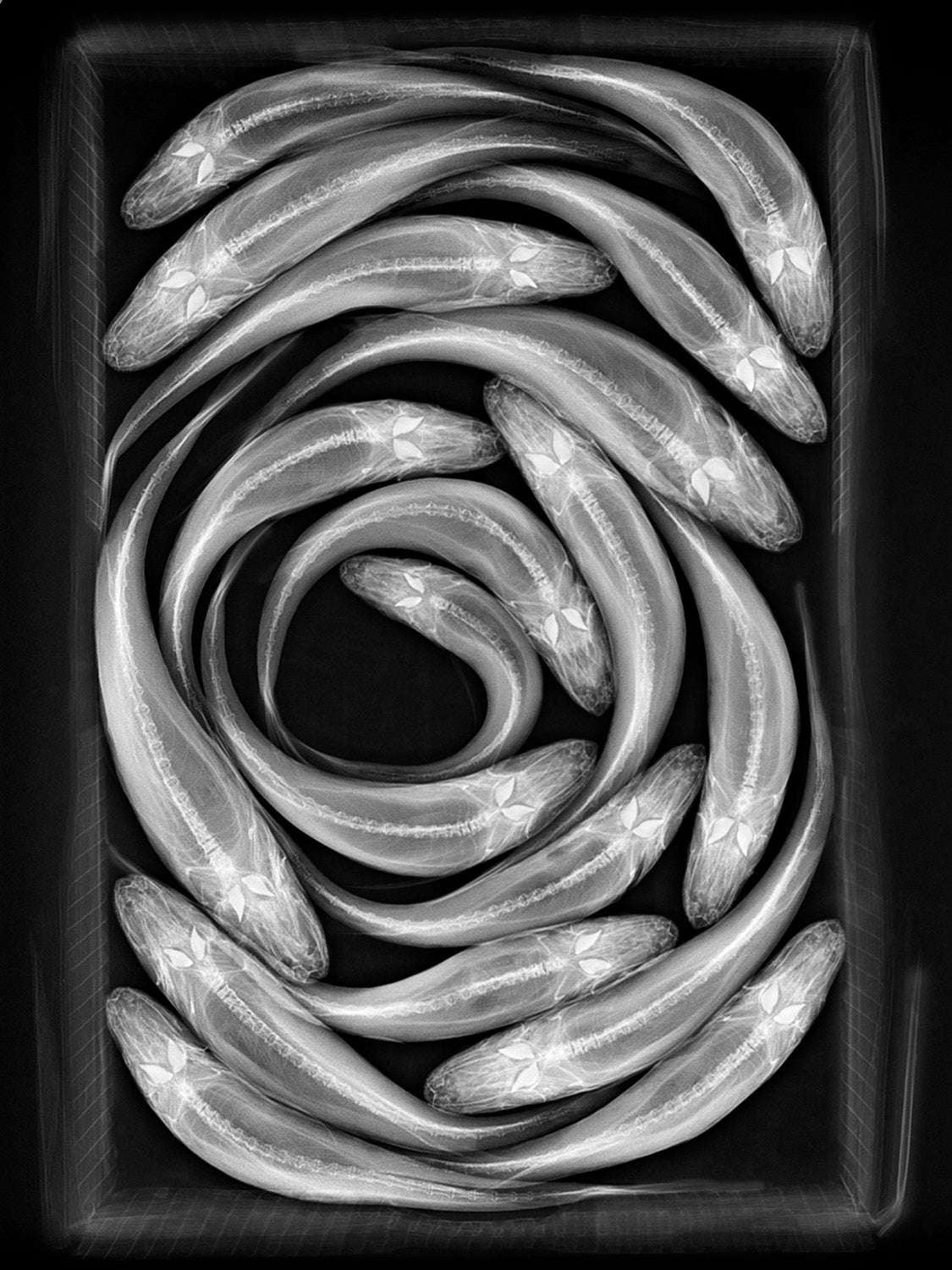
About the Seller
5.0
Vetted Professional Seller
Every seller passes strict standards for authenticity and reliability
Established in 1990
1stDibs seller since 2010
131 sales on 1stDibs
Typical response time: 4 hours
- ShippingRetrieving quote...Shipping from: Hudson, NY
- Return Policy
Authenticity Guarantee
In the unlikely event there’s an issue with an item’s authenticity, contact us within 1 year for a full refund. DetailsMoney-Back Guarantee
If your item is not as described, is damaged in transit, or does not arrive, contact us within 7 days for a full refund. Details24-Hour Cancellation
You have a 24-hour grace period in which to reconsider your purchase, with no questions asked.Vetted Professional Sellers
Our world-class sellers must adhere to strict standards for service and quality, maintaining the integrity of our listings.Price-Match Guarantee
If you find that a seller listed the same item for a lower price elsewhere, we’ll match it.Trusted Global Delivery
Our best-in-class carrier network provides specialized shipping options worldwide, including custom delivery.More From This Seller
View All"Downtown Los Angeles, September 2005", Los Angeles, 2005
By Thomas Michael Alleman
Located in Hudson, NY
The skewed perspective and stark contrasts of dark and light gives a new point of view to the infamous Hollywood Walk of Fame. The rays of light cast upon the star give a sense of th...
Category
21st Century and Contemporary Contemporary Black and White Photography
Materials
Archival Pigment
San Fernando Valley, Los Angeles
By Thomas Michael Alleman
Located in Hudson, NY
Black and White, Car, Urban, Los Angeles, Sky, american, b&w, black & white, urban photography, vehicle, bikes, driving, bicycle, motion blue, vignette, van, high contrast, California
Listing is for UNFRAMED print. Inquire within for framing.
Edition of 25.
If the exhibition piece is sold or the customer orders a different print size, the photograph is produced upon purchase. Please allow two weeks for production.
Shipping time depends on method of shipping.
Price is subject to availability. The Robin Rice Gallery reserves the right to adjust this price depending on the current edition of the photograph.
ABOUT:
Since the inception of Sunshine & Noir in 2001, Alleman has shot extensively in Los Angeles, New York, San Francisco and other American cities. In his latest iteration Alleman takes a detour beyond the frenetic landscapes of urban America into Paris - playfully guiding the viewer through a simultaneously familiar and foreign geography.
In the exhibition, square and panoramic landscapes and iconic landmarks stretch across the gallery, where Alleman creates intrigue by re-expressing instantly recognizable subjects. Images with blurred, vignetted edges epitomize his surrealist style, haunting throughout the series. His artful mastery at capturing movement is seen in the invitational image, San Fernando Valley...
Category
21st Century and Contemporary Photography
Materials
Archival Pigment
Hollywood
By Thomas Michael Alleman
Located in Hudson, NY
Black and White, Urban, American, Los Angeles, hollywood, street sign, street, highway, black & white, b&w, vignette, high contrast, car, driving, motion
Listing is for UNFRAMED pri...
Category
21st Century and Contemporary Photography
Materials
Archival Pigment
"Mount Hollywood, October 2004", Los Angeles, 2004
By Thomas Michael Alleman
Located in Hudson, NY
Listing is for UNFRAMED print. Inquire within for framing.
Edition 1 of 25.
If the exhibition piece is sold or the customer orders a different print size, the photograph is produced upon purchase. Please allow two weeks for production.
Shipping time depends on method of shipping.
Price is subject to availability. The Robin Rice Gallery reserves the right to adjust this price depending on the current edition of the photograph.
Thomas Alleman’s urban landscapes convey the pulsating energy and sensual excitement of city life. With an eye for the visual rhythms and geometry of buildings, highways and parks, his photographs transform ordinary structures and events into emotionally charged images of modern life. “Hollywood Freeway...
Category
21st Century and Contemporary Contemporary Photography
Materials
Archival Pigment
Santa Monica
By Michael McLaughlin
Located in Hudson, NY
Listing is for UNFRAMED print. Inquire within for framing.
Edition of 7.
If the exhibition piece is sold or the customer orders a different print size, the photograph is produced upon purchase. Please allow two weeks for production.
Shipping time depends on method of shipping.
Price is subject to availability. The Robin Rice Gallery reserves the right to adjust this price depending on the current edition of the photograph.
ABOUT:
Your Nearest Exit May Be Behind You, a reference to the traditional pre-flight instructions of airline hostesses, is fine art photographer Micheal McLaughlin's collection of the sights found universally in the act of travelling between countries and continents. From dark Hong Kong skylines...
Category
21st Century and Contemporary Color Photography
Materials
Archival Pigment
"Hollywood, October 2005", Los Angeles, 2005
By Thomas Michael Alleman
Located in Hudson, NY
An unconventional rendering of the classic Hollywood sign.
Thomas Alleman’s urban landscapes convey the pulsating energy and sensual excitement of city life. With an eye for the vis...
Category
21st Century and Contemporary Contemporary Black and White Photography
Materials
Archival Pigment
You May Also Like
Dodger Stadium Almost Game Time Again - Urban Photography Painting Art on Paper
By Pete Kasprzak
Located in Los Angeles, CA
Pete Kasprzak’s passion for city life is expressed in his dynamic urban artworks. Kasprzak’s artworks express energy and life with animated brush strokes. He adds dynamic movement an...
Category
21st Century and Contemporary Contemporary Landscape Photography
Materials
Mixed Media, Acrylic, Photographic Paper
Dodger Stadium Sky High - 7th Inning - Abstract Colorful Photo Landscape Artwork
By Pete Kasprzak
Located in Los Angeles, CA
Pete Kasprzak’s passion for city life is expressed in his dynamic urban artworks. Kasprzak’s artworks express energy and life with animated brush strokes. He adds dynamic movement an...
Category
2010s Contemporary Landscape Paintings
Materials
Mixed Media, Acrylic, Photographic Paper
Dodger Stadium Sky High - Original Acrylic on Photograph Cityscape Los Angeles
By Pete Kasprzak
Located in Los Angeles, CA
Pete Kasprzak’s passion for city life is expressed in his dynamic urban artworks. Kasprzak’s artworks express energy and life with animated brush strokes. He adds dynamic movement and texture with oil and acrylic paint on his mixed media cityscape artworks.
“Every work of art I create portrays a symbolic visual of the urban culture surrounding me. I give my artworks depth and movement with carefully chosen brush strokes lying on top of them. Some of my pieces have few strokes and sometimes they have many. It depends on the energy and motion I want to reflect in the artwork.”
Pete Kasprzak created this one-of-a-kind 11-inch high by 14-inch wide mixed media artwork by applying acrylic paint on a photograph. The unique textures and reflection of the paint set themselves apart from the smooth background. It is signed with the artist's initials on the front; and signed, titled, and dated on the back. Affordable U.S. and global shipping is available. A certificate of authenticity issued by the art gallery is included.
Kasprzak’s artworks have been exhibited throughout the United States and Canada. He has been a featured artist in “The Artist Project”, one of North America’s largest art shows, winning the “People’s Choice Award”. Successful collaboration pieces include artworks featuring Motley Crue, Rob Zombie, Jon 5, Mix Master Mike, Tommy Lee, and Phil X from Bon Jovi. Kasprzak is always striving to let his creativity express in new forms. Kasprzak has developed a vibrant style of art that has been exhibited across Canada and the United States.
REPRESENTATION
Artspace Warehouse, Los Angeles, CA
EXHIBITIONS
2023 “Present Future”, Artspace Warehouse, Los Angeles, CA
2021 “Urban Thoughts”, Artspace Warehouse, Los Angeles, CA
2020 “Midnight Blue”, Artspace Warehouse, Los Angeles, CA
2018 Art Therapy Outreach Centre 5th Anniversary Gala, NY
IndyFest Spartans Lodge, Studio City, CA
Local’s Only Art Show at Clean Aesthetic
2017 Artspace Warehouse, Los Angeles, CA
Affordable Art Fair New York, NY
The Kicktail Art Mixer, Los Angeles, CA
Art Showcase Guelph, Guelph, Canada
2016 Affordable Art Fair New York, NY
Artspace Warehouse, Los Angeles, CA
2015 Victory Fashion Show, Los Angeles, CA
Contact Photography Festival, Toronto, Canada
2014 Happy Birthday Toronto
Steamwhistle Gallery, Toronto, Canada
Contact Photography Festival, Toronto, Canada
2013 KGB Studios Art Show, Los Angeles, CA
Contact Photography Festival, Toronto, Canada
Melrose Fame Fest, Los Angeles, CA
2012 Norman Felix Gallery, Toronto, Canada
The Artist Project, Toronto, Canada
2011 The Artist Project, Toronto, Canada
Galaria; The Artist’s Alley, San Francisco, CA
Norman Felix Gallery, Toronto, Canada
2010 Toronto Outdoor Art...
Category
21st Century and Contemporary Contemporary Landscape Photography
Materials
Mixed Media, Acrylic, Photographic Paper
Dodger Stadium (The Last Picture Show)
By Stefanie Schneider
Located in Morongo Valley, CA
Dodger Stadium (The Last Picture Show) - 2000,
20x20cm,
Edition of 10 plus 2 Artist Proofs.
Archival C-Print, based on the original Polaroid. Certificate and Signature label.
...
Category
Early 2000s Contemporary Landscape Photography
Materials
Archival Paper, Photographic Paper, C Print, Color, Polaroid
Dodgers Stadium, Los Angeles, 1991
By Steve McCurry
Located in New York, NY
Kal Daniels, Darryl Strawberry, and Gary Carter, Dodgers Stadium, Los Angeles, 1991
Price Upon Request
Dodger Stadium from the Sky (Blue) - Landscape Photography Painting Art on Paper
By Pete Kasprzak
Located in Los Angeles, CA
Pete Kasprzak’s passion for city life is expressed in his dynamic urban artworks. Kasprzak’s artworks express energy and life with animated brush strokes. He adds dynamic movement an...
Category
21st Century and Contemporary Contemporary Landscape Photography
Materials
Mixed Media, Acrylic, Photographic Paper
More Ways To Browse
Theater Marquee
Used Stadium Lights
Historical Monuments
Ship Photography
Greece Photography
Palm Springs Slim Aarons
Cloud Photographs
Porn Art
Human Skin
Slim Aarons Bermuda
Slim Aarons New York
Landscape Photograph Vintage
Truman Capote
New Mexico Photography
St Tropez Art
Surfer Prints
Photography Chrysler Building
Portraiture Nude
